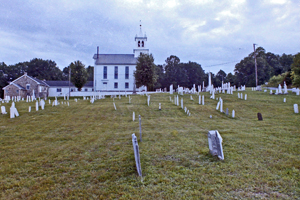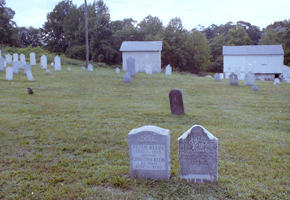Home
David Mertz
Peter Mertz
Peter Mertz,
Jr.
Jonathan
Martz
Simon Martz
Vandine
Martz
Charles M. Martz
James V. Martz
Frederick
Braun
Isaac Bubb
Adam Elliot |
(Johan) David Mertz
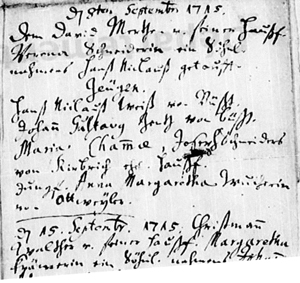 September 8, 1715 September 8, 1715
Hans Niclaus son of David
and Verena Mertz is baptized.
-Wintersbourg- Registres Paroissiaux
(Avant 1793)-Paroisse protestante (Avant 1793)
Registre de baptêmes et de Mariages 1688-1729 –
Original en mairie, retrieved from
archives.bas-rhin.fr on 5/17/2016
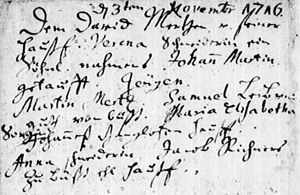 November
3, 1716 November
3, 1716
Johan Martin
Mertz, son of David and Verena Mertz
is baptized.
-Wintersbourg-
Registres Paroissiaux (Avant 1793)-Paroisse
protestante (Avant 1793) Registre de
baptêmes et de Mariages 1688-1729 – Original
en mairie, retrieved
from archives.bas-rhin.fr on 5/17/2016
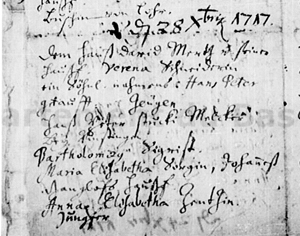 December 28, 1717 December 28, 1717
September 20, 1722
David Mertz from Hangenweiller
[Hangviller] and wife Frena [Veronica] nee Schneider
had a son: Johannes [Mertz] baptized 20 Sept.
1722. Sponsors: Johannes Scheüer, citizen and
master tailor at Weyer; Lorenz Teüschen,
shepherd at Bälingen; Eva, wife of Nicholas
Schneider, schoolmaster at Rauweiller; Catharina,
daughter of Ludwig Morel from Sieweiller
[Drulingen].
-Annette Kunselman Burgert, Eighteenth
Century Emigrants from the Northern Alsace to
America, Picton Press, Camden Maine, 1992, p. 363
(Note:
David and Veronica are probably the immigrant
family for this line (see 9/28,1733). Apparently
this child did not survive to make the trip to the
"new land."-rjm)
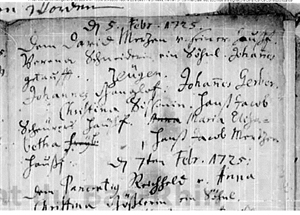 February 5, 1725 February 5, 1725
Johan Mertz is
baptized, died on April 25th 1730, however.
-Wintersbourg-
Registres Paroissiaux (Avant 1793)-Paroisse
protestante (Avant 1793) Registre de baptêmes et
de Mariages 1688-1729 – Original en mairie,
retrieved from archives.bas-rhin.fr on 5/17/2016
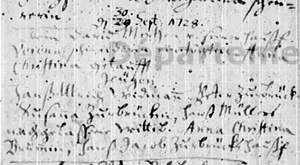 September
30, 1728.
Anna
Christina Mertz is baptized.
-Wintersbourg-
Registres Paroissiaux (Avant 1793)-Paroisse
protestante (Avant 1793) Registre de baptêmes et
de Mariages 1688-1729 – Original en mairie,
retrieved from archives.bas-rhin.fr on 5/17/2016
September 28, 1733 Friday
The brigantine
"Richard and Elizabeth" arrives from the
Palatine at the Port of Philadelphia, Christopher
Clymer, master, from Rotterdam and last
from Plymouth (England). Listed are:
David
Mertz, 44, wrote his initials
Veronica
[Schneider] Mertz, 40, wife of David
Johannes
Nicholas Mertz, 18
Johannes
Peter Mertz, 13¾
Christina
Mertz, 3¾
-Annette Kunselman Burgert, Eighteenth
Century Emigrants from the Northern Alsace to
America, Picton Press, Camden Maine, 1992
-Pennsylvania
German Pioneers, Volume 1, pp.
126-128, (cited by Heber G. Gearhart)
-Austin M.
Schaeffer, Mertz Family
Record,,
manuscript, Reading, Pennsylvania
-Ralph Fraley Martz, The Martz's of
Maryland,1973
(Note:
Annette Burgert cites the following:
"Verification of this emigration supplied by Dr.
Bernd Gölzer, from the county records of
Nassau-Saarwerden, compiled by Dr. Gerhard Hein:
Records of the Saarwerden county office for
Kirberg: dated 18 Oct. 1764, contemporary table
of descendents of Joseph Schneider of
Diedendorf, originally from Melchnau, BE. Veronica
Schneider, wife of David Mertz, was a
daughter of Joseph Schneider. David
Mertz of Hangweiler and wife Veronica have moved
to the New Land with three children: 1. Hans
Nickel, 2. Hans Peter, 3. Christina." This
family migrated to Longswamp Township, Lancaster
(now Berks) County, Pennsylvania. Ralph Fraley
Martz names the eldest son Hans Michael Mertz
also known as John Nichol Mertz. The term
Palatine or Palatinate is used commonly to refer
collectively to the several provinces of
southwest Germany bordering the Alsace-Lorraine
and Switzerland and included in the present
states of Rhineland-Pfalz, Hessen, and
Baden-Wurttemburg. -rjm)
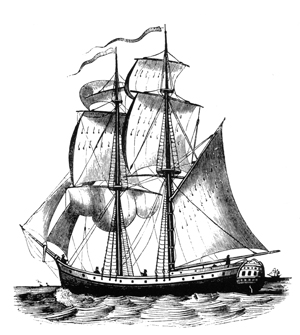 The condition in which
the [Palatine] immigrants reached Philadelphia was
shocking. The ships were floating hospitals and
pest-houses filled with small-pox and all the
other diseases of crowding and dirt which gathered
frightful intensity from the voyage of two or
three months. One ship reached the coast, after a
voyage of six months, with the surviving
passengers living on rats and vermin. Vessels
often lost on the passage one-third of their human
freight, and one ship is said to have arrived
after having lost two hundred and fifty. The condition in which
the [Palatine] immigrants reached Philadelphia was
shocking. The ships were floating hospitals and
pest-houses filled with small-pox and all the
other diseases of crowding and dirt which gathered
frightful intensity from the voyage of two or
three months. One ship reached the coast, after a
voyage of six months, with the surviving
passengers living on rats and vermin. Vessels
often lost on the passage one-third of their human
freight, and one ship is said to have arrived
after having lost two hundred and fifty.
Sauer said
that in one year two thousand of the Germans had
died in crosssing and this estimate does not seem
to be excessive. The Palatine ship that was
wrecked on Block Island in 1738, and celebrated in
Whittier's verse, is said to have
started out with four hundred passengers, who at
the time of the wreck were reduced by a malignant
fever and flux to one hundred and five, and of
this remnant ten died a few days after they were
taken ashore.
The delays in the voyage were
numerous. Before reaching the ship the people had
to pass through thirty or forty custom-houses on
the Rhine, at each of which they were delayed
often several days, so that this Rhine journey
usually consumed five or six weeks, and completely
exhausted their slender stock of money and
provisions. Other delays of five or six weeks
occurred at the seaports, and the poor immigrants,
starving and desperate, sold themselves as
redemptioners to the captains and shipping agents.
Mittelberger, in his "Journey to
Pennsylvania in 1750", has described what they
suffered on the voyage:
"In Rotterdam and Amsterdam
they begin to pack the people in like herring, and
since the ships insist on carrying not less than
four, five, or six hundred souls, besides enormous
cargoes of household utensils, chests, water
casks, and provisions, many are obliged to occupy
berths scarcely two feet wide by six long. . . .
"It is not, however, till the
ship has raised its anchor for the last time and
started on its eight, nine, ten, eleven, or twelve
weeks' sail for Philadelphia that the greatest
misery is experienced. Then there are
heart-rending scenes! The filth and stench of the
vessels no pen could describe, while the diverse
diseases, sea-sickness in every for, headaches,
biliousness, constipation, dysentery, scarlet
fever, scrofula, cancers, etc., caused by the
miserable salt food and the vile drinking water
are truly deplorable, not to speak of the deaths
which occur on every side.
"In addition to all this, one
invariably meets with an actual scarcity of every
kind of provisions, with hunger, thirst, frost,
severe heat, an ugly wet vessel, murmurings,
complaints, anxiety, loathsome contagious
diseases, and other innumerable varieties of
tribulations, such as lice in such numbers that
they can literally be taken in quantities from the
bodies of the passengers, especially the sick.
Forlorn, though, as the situation is, the climax
is not yet reached. That comes when, for the space
of two or three days, all on board, the sick and
dying as well as those in health, are tossed
mercilessly to and fro, and rolled about on top of
one another, the storm-tossed vessel seeming each
moment as if in the next it would be engulfed by
the angry, roaring waves. . . .
"Even those who escape
sickness sometimes grow so bitterly impatient and
cruel that they curse themselves and the day of
their birth, and then in wild despair commence to
kill those around them. Want and wickedness go
hand and hand, and lead to trickery and deception
of every kind. One blames another for having
induced him to undertake the voyage. Husbands
reproach their wives, wives their husbands,
children their parents, parents their children,
and friends their friends, while all denounce the
cruel Newlanders whose trade it is to steal human
beings.
"Many heave deep draw sighs,
and exclaim, mournfully, 'O God! O God! if I only
had a piece of good bread or one drop of fresh
water!' or cry out in the anguish of their souls,
'Oh, if I were only at home and lying in my
pig-sty!' The wailings and lamentations continue
day and night, and, as one body after another is
committed to a watery grave, those who induced
their unfortunate companions to leave their old
home in search of a new are driven to the verge of
despair.
"The sufferings fo the poor
women who are pregnant can scarcely be imagined.
They rarely live through the voyage, and many a
mother with her tiny babe is thrown into the water
almost ere life is extinct. During a severe storm
on our vessel one poor creature, owing to the
trying circumstances, was unable to give birth to
her child, was shoved through an opening in the
ship and allowed to drop into the water, because
it was not convenient to attend to her. . . .
"It is little wonder that so
many of the passengers are seized with sickness
and disease, for, in addition to all their other
hardships and miseries, they have cooked food only
three times a week, and this (it is always of a
decidedly inferior quality, and served in very
small quantities) is so filthy that the very sight
of it is loathsome. Moreover, the drinking water
is so black, thick, and full of worms that it
makes one shudder to look at it, and even those
suffering the tortures of thirst frequently find
it almost impossible to swallow it."
-The Making of
Pennsylvania, Sidney George Fisher, Ira J. Friedman,
Inc, Port Washington L.I., N.Y., 1896
During 1734
The first
settlers arrive at Longswamp Township, Berks
County, Pennsylvania. They are chiefly Germans,
who have come from nearby Goshenhoppen and Oley
Townships. The first person to come here is said
to have been a man named Berger,
who settled in Long's Dale. These early settlers
found the land low and swampy, covered with sour
grass and thickets, and for this reason gave it
the name it still retains.
-The Story of Berks
County,
A.E. Wagner, F.W. Balthaser, D.K. Hoch, Reading
Eagle Co., 1913
and . . .
The first
settlers from Oley, lying to the southwest, and
those from Goshenhoppen, east of south, came to
this section in 1734-35. A few among the first
from Oley arrived in 1710. These early settlers
certainly had a hard time of it. We are told that
for a time at least, the branches of trees formed
the roofs of their kitchens, and the body of their
wagons, their sleeping rooms. . . . The name is
said to have originated from the fact that along
the whole length of Toad Run (Krottecrick) a small
stream of water, flowing eastward from Topton
along this ridg, until it empties into the Little
Lehigh, the land was marshy and so this narrow
swamp strip was called Longswamp. Another story
goes that a number of people by the name of Long
or Lang owned this swampy land and was called
therefore Long's Swamp. The name was naturally
contacted to "Longswamp". The present name
"Longsdale" would seem to justify such a
supposition. Settlements were fairly commenced in
1734. They increased year by year. The large
majority of them were Reformed - Palatines, Swiss,
and Huguenots.
-Reading Daily Times, Rev. J. W. Early, July
2 - November 8, 1907
-Lutherans in Berks
County,
1723-1923, H.S. Kidd, Reading Conference of the
Evangelical Lutheran Ministerium of Pennsylvania
and Adjacent States
Skizze Vum
Langschwamm
. . .
Die erscht [Kaerrich] iss im Yohr 1748
gebaut warre un die zwett in 1791. Die
erscht hot g'schtanne wu nau's "Tool House"
schteht, un die zwett war graad g'schwische
daerer un der wu heit uff em Baerrick
schteht. Wie die zwett gabaut sei hot solle,
hen die Vetter net eenich warre kenne, wu
sie hie g'schtellt sei sott. Um eenich zu
warre, hen sie die Hiet in die Luft
g'schmisse, un wu der greescht Haufe vun
Hiet war, dart iss di Kaerrich hie gebaut
warre! Wie viel besser waer's doch heit
wann, statts beese Warde un zwar noch
Kuggle, die Hiet in die Luft g'schmisse daet
warre! Sie Kumme all widder runner!
Die Gemee iss awwer
doch elter als die erscht Kaerrich. Sie iss
net weit vun zwee hunnert Yohr alt. Wann mer
draa denkt vann unser Voraeltere numma sin
un wees wie 's in selle friehere Yohre wor,
wu noch ken Kaerriche wore un dass sie waerd
manches glor warre. Die Voreltere hen
Grishctendum g'hat un hen aa an irhrem
Handwer g'schafft!
Die folgende Ansiedler sin aakumme in
Philadelphia, an de Zeit wie so aagewwe iss:
Joseph Biery, 27. August
1739.
Sam Burger, 3.
September 1739.
Jacob Burger, 3.
September 1739.
Philip Burger, 3.
September 1739.
Robert Kreber, 3.
September 1739.
Theobald Carl, 9.
September 1739.
Joseph Fenstermacher,
9. September 1738.
Fred. Helwig, 12.
October 1741.
Philip Fenstermacher,
30. August 1737.
Johannes Deal, 27.
August 1739.
Peter Butz, 9. November
1738.
Nicholas Schwartz, 3.
September 1739.
Nicholas Mertz, 28.
September 1733.
David Mertz, 28.
September 1733.
Peter Mertz, 28.
September 1733.
Heinrich Bollenger, 5.
September 1738.
Christian Ruth, 30.
August 1737.
Michael Neitner, 3.
September 1739.
Bernhart Fegely, 3.
August 28 1733.
Jacob Long, 30. August
1737.
Der Naame im erschte
Deed war: "The German Calvinistic
Congregation of Longswamp Township, Berks
County." Ferwas "Longswamp"? So viel wolle
vun Sache schreiwe vun denne sie nichs
wisse. 'S Township iss kenne Familie
nohg'heese warre. In friehere Zeit war's
Daal vun wu Topton nau iss bis nunner an die
Northampton County (nau Lecha) Line, 'n
grosser Schwamm - sumpich Land - gewest, un
doher der Naame "Longswamp." Topton is graad
in der Mitt g'schwische Reading un Allentown
un iss aa der Gippel, so dass die Leit dart
saage kenne, "Nunner noch Reading" un aa
"Nunner noch Allentown." Hinner Topton fangt
die glee Lecha aa un aa die Grotte Krick.
Die fliesse Oscht un wennich weiter West
geht's Wasser der anner Weg.
Die glee Lecha geht
darrich's Longedaal un kummt dann hinne rum
darrich Nieder Longschwamm un geht iwwer 'n
halwi Meil nordlich un dann widder Oscht.
Die Grotte Krick is weiter nordlich un geht
darrich Hancock un Mertztown nunner bis sie
dann im Butze Daal in de glee Lecha fliesst.
An der gleene Lecha
ware die Hilberts Miehl un Saegmiehl,
schpaeter die Fritche Miehl; die Philip
Bastress Wollkratz Miehl (schpaeter war der
Marchus Long der Eegner); un dann dem Joseph
Biery sei Mahl- un Saegmiehl; dann weiter im
Daal drunne die Egners Miehle, schpaeter die
Waghenost Miehle. Awwer wu sin die Miehle
heit? Die menschte sin "Only a memory!".
An der Grotte Krick hot's ken Miehle g'hat.
'S iss yuscht 'n Winter Krick. Im Summer
dhune ewwe die Moschgieter verdarschte! Doch
wann 's reggert, geht's wie's Lescher's
Miehl: "Nau kann ich mir selwer helfe." Sie
waerd so luschdich as wie 'n Haersch wann
die Hund ihm nohgehne. Wasser! Wasser! Ich
denk! Doch kens far's Vieh wanns Vieh am
darschtichscht iss!
In de erschte Yohre war
des Land im Daal vun viele verhasst gewest,
un deswege hen sich viele an die Baerrye
g'henkt un sin aarm gebliwwe. Die awwer wu
weiter naus geguckt hen, sin iwwer der
Schwamm naus gange un sin gut aakumme. . . .
Mertztown is der Mertz
Familie nohg'heesse warre in 1857. Die
Mertze hen schun iwwer 'n hunnert Yohr
frieher dart gewuhnt. . . .
Die Eiwhohner vun
Langschwamm in 1800 ware 863; in 1900,
2,507. . . .
-Charles A. Butz. The Morning
Call, Allentown, Pa., January 7,
1939
|
Sketch of
Longswamp
. . .
The first [church] was built in 1748 and the
second in 1791. The first one stood where
the present tool house stands, and the
second was exactly halfway between there and
where the present one stands at the top of
the hill. None of the fathers knew how the
second should be built, where it should be
put. In order to decide they threw their
hats into the air, and where the greatest
pile of hats was, that's where the church
would be built! How much better would it be
still today, instead of angry words and even
bullets, throwing hats into the air would
be. They all come down again!
The congregation is however older than the
first church. It is at least 200 years old.
When one thinks of how our ancestors arrived
and knows how it was in those early years,
where there was no church and that they held
worship services in their homes -then it
becomes much clearer. The ancestors were
Christians but also had their trades to do.
The following colonists arrived at
Philadelphia, at the time reported here:
Joseph Biery, August
27, 1739
Sam Burger, September
3, 1739
Jacob Burger, September
3, 1739
Philip Burger,
September 3, 1739
Robert Kreber,
September 3, 1739
Theobald Carl,
September 3, 1739
Joseph Fenstermacher,
September 9, 1738
Fred. Helwig, October
12, 1741
Philip Fenstermacher,
August 30, 1737
Johannes Deal, August
27, 1739
Peter Butz, November 9,
1738
Nicholas Schwartz,
September 3,1739
Nicholas Mertz,
September 28, 1733
David Mertz, September
28, 1733
Peter Mertz, September
28, 1733
Heinrich Bollenger,
September 5,1738
Christian Ruth, August
30, 1737
Michael Neitner,
September 3, 1739
Bernhart Fegely, August
28, 1733
Jacob Long, August 30,
1737
The name on the first
deed was: "The German Calvinistic
Congregation of Longswamp Township, Berks
County." Why "Longswamp"? So many intend to
write of events who don't know. The township
was not named after a family. In earlier
time, the was valley from where Topton is
now down to the Northampton County (now
Lehigh) Line, was a great swamp - marshy
land - and therefore named "Longswamp".
Topton is halfway between Reading and
Allentown and is at the highest point, so
that the people there are heard to say "down
toward Reading" and also "down toward
Allentown". Behind Topton the Little Lehigh
and the Toad Creek begin. They flow east,
but a little farther west the water goes the
other way.
The Little Lehigh goes through Longdale and
then comes around behind through Lower
Longswamp and goes over a half mile north
then again east. The Toad Creek is farther
to the north and goes through Hancock and
Mertztown then down into Butze Dale into the
Little Lehigh.
On the Little Lehigh
were Hilbert's mill and sawmill, later
Fritche mill; the Philip Bastress
woolcarding mill (later Marcus Long was the
owner); and then to Joseph Biery's meal and
saw mill; then later the Trexler's mill and
tannery; then farther in the valley down to
Egners mill, later the Wahgenost Mill. But
where are the mills now? Most are "only a
memory"!
There can be no mills
on the Toad Creek. It is only a creek in the
winter. In the summer even the mosquettos
die of thirst! Nevertheless, when it rains,
it goes like Lesher's Mill: "Now I can help
myself". It becomes as merry as a deer when
the hound chases him. Water! Water! I
imagine! Yet none for the benefit of cows
when cows are depending on it.
In the first years the
land in the valley was much hated, and
therefore many stayed in the hills and
remained poor. However those who looked
further went over the swamp and prospered
well. . . .
Mertztown was named
after the Mertz family in 1857. The Mertzes
had lived there over a hundred years before.
The population of
Longswamp in 1800 was 863; in 1900, 2,507. .
.
|
September, 1748
The first Longswamp
Reformed Church is built and
among the contributors are Nicolaus Mertz,
David Mertz, and Peter
Mertz.
The church is located on the
northern slope of a spur of the Lehigh hills,
elsewhere known as South Mountain, near the
eastern boundary of Longswamp Township. . . . This
in the opinion of Dr. [W.A.] Helffrich, who
advances excellent reasons for his view, was tho
original Little Lehigh church. Some of the sources
of that stream are formed here. It is the only
church besides the Galzburg or Galisburg Church,
then known as the Schmalzgrass, located on this
stream. Rev. Father Michael, pioneer of the
Reformed Church mentions it as the "Little Lehigh
Church" in his records. Schlatter could not
possibly have meant the church which still bears
the name "Lehigh church" at the present time, as
that was exclusively Lutheran then. The name
Longswamp, as applied to this church, was
introduced as early as 1762. Frederick Hoelwig,
cantor of the congregation, gives 1748 as the time
of organization. But prior to this, services had
been held in private houses, sermons being read. .
. As usual in those days, the church was built of
logs, the interstices being filled with small
blocks or large chips, plastered over with clay.
The seats were hewn planks. It is not stated
whether the floor was of brick, of flags, or the
native earth. This building remained in use about
43 years. The first church stood near where the
present toolhouse stands in the cemetery.
The piece of ground which the
members had selected was lawfully secured by Jost.
H. Sassamanhausen through a warrant.
Afterwards the congregation bought ine acres for
the purpose of erecting a school-house thereon and
for the use of the school-teacher. Both tracts
were patented for the perpetual use of the
Reformed congregation, which was not a union one
originally, but so hard Reformed that the
Lutherans who came afterward were pressed farther
down into the valley, where they likewise
established a congregation on the Little Lehigh.
The Reformed in Germany were
not very much given to the doctrines distinctively
known as Cavinism, and those of them who came to
this country were still less inclined to such
principles. They differed from the Lutherans in
being, perhaps, more metaphysical or speculative,
and more severe in their forms of worship. The
Lutherans permitted images, altars, tapers,
private confessional, and had a belief which
somewhat resembled the doctrine of the real
presence. All these were rejected by the Reformed.
The Lutherans were closely connected with the
State in Germany, while the Reformed were always
independent of it.
-History of Berks
County Pennsylvania, Montgomery
-Lutherans in Berks
County,
1723-1923, H.S. Kidd, Reading Conference of the
Evangelical Lutheran Ministerium of Pennsylvania
and Adjacent States
-The Making of
Pennsylvania, Sidney George Fisher, Ira J. Friedman,
Inc, Port Washington L.I., N.Y., 1896
-Church
Record of the Longswamp Reformed Church, Longswamp Township,
Berks County, Pennsylvania
-Rev.
J.W. Early, Reading Daily Times,
July 2 - November 8, 1907
(Note: The present site of the
church is further up the hill from this original
building (see below). -rjm)
November 23,
1752 (Thursday)
Nicholas
Mertz receives land warrant no. 12 for
50 acres. In addition, he received warrant no. 18
on 5/29/1753 for 16 acres, and warrant no. 30
dated 12/29/1753 for 34 acres. It is said that
Mertztown, Longswamp Township, is located on this
land.
-The Martzes of
Maryland,
Ralph Fraley Martz, 1973 (cites Survey Book A-D-C)
Below: (left) the present Longswamp Church (built in
1852) looking southwest from the grave yard as it
appeared on a stormy day in 1988. The two stones in
the right foreground are for Peter and Christina
Mertz Klein (also shown at the right, looking
northwest) the older one for Peter Klein was
temporarily covered at the time for preservation. No
stones are found for David or Peter Mertz. The
location of the original church building was at the
lower northern corner of the graveyard behind and to
the right of the Klein stones.
|

 September 8, 1715
September 8, 1715 November
3, 1716
November
3, 1716 December 28, 1717
December 28, 1717
 February 5, 1725
February 5, 1725  September
30, 1728.
September
30, 1728. The condition in which
the [Palatine] immigrants reached Philadelphia was
shocking. The ships were floating hospitals and
pest-houses filled with small-pox and all the
other diseases of crowding and dirt which gathered
frightful intensity from the voyage of two or
three months. One ship reached the coast, after a
voyage of six months, with the surviving
passengers living on rats and vermin. Vessels
often lost on the passage one-third of their human
freight, and one ship is said to have arrived
after having lost two hundred and fifty.
The condition in which
the [Palatine] immigrants reached Philadelphia was
shocking. The ships were floating hospitals and
pest-houses filled with small-pox and all the
other diseases of crowding and dirt which gathered
frightful intensity from the voyage of two or
three months. One ship reached the coast, after a
voyage of six months, with the surviving
passengers living on rats and vermin. Vessels
often lost on the passage one-third of their human
freight, and one ship is said to have arrived
after having lost two hundred and fifty. 